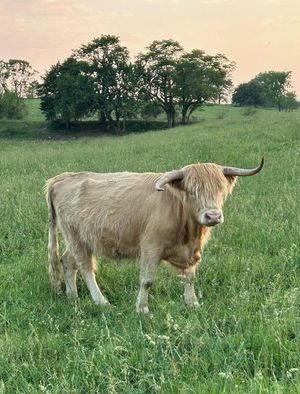Joining the Rolling Hills Zoo family is a new species of cattle, the Highland. This shaggy-haired, long-horned breed is closely associated with the beauty, mystery and romance of the Scottish Highlands, but underneath all of that hair is a useful and productive breed of cattle.
Now about 5 years old, Freya was purchased from a farmer in Missouri. Named by her keeper Cody, the name Freya is associated with the goddess of love and maternity and is considered a highly feminine choice within classical mythology, meaning “lady”.
Freya’s new habitat is in the former ostrich yard near the Nature Playground. Prior to her arrival, the ostrich were relocated to a more central location in the zoo, closer to the painted dogs.
A descendant of the native cattle of Scotland, the Highland breed is best known for its survival qualities, hardiness, maternal abilities, reproductive efficiency and longevity. Highland cattle thrive on rough forage and in cold, wet climates. Like the other Scottish beef breeds, the Galloway, Belted Galloway and Angus, the Highland is celebrated for the excellence of its beef.
The early history of Highland cattle is not well recorded, though the breed was improved during the 1800s through natural selection. Highlands are medium in size, with cows weighing 900 to 1,300 pounds and bulls 1,500 to 2,000 pounds. They have long, shaggy coats that are most commonly light red, but many other solid colors are also seen, including black, brindle, cream, dun (a dull grayish brown), red and white. The horns of the Highland cows sweep out and up, while those of the bulls are horizontal with upturned tips.
In 2019, Highland breed became numerous enough to graduate from the Livestock Conservancy’s Conservation Priority List, meaning that there are more than 1,000 annual registrations in the United States and more than 25,000 animals registered globally.
Their dramatic shaggy coats and long horns make them true conversation starters for agritourism operations. While this breed has become an international resource for beef production in marginal landscapes, another important use is conservation grazing, securing their niche as productive partners in effective range management around the globe.


